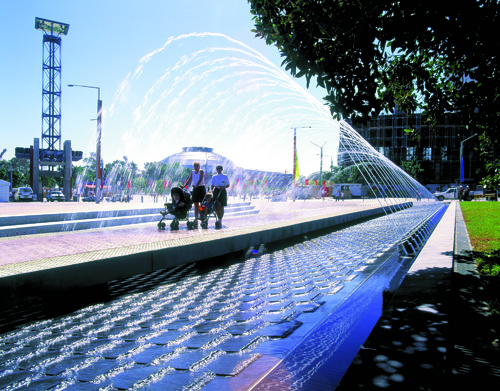
When millions around the world watch the Sydney Olympic Games this September, they will also be experiencing the best of Australian architecture, with particular emphasis on stainless steel.
Stadium Australia, located at Homebush Bay in Sydney's inner city in the centrepiece of the Olympic site. Here, events such as the opening and closing ceremonies and the track and field program will be played out. Closer examination of the sit reveals the use of stainless steel in a myriad of applications, both aesthetic and functional. Perhaps more importantly, the use of stainless steel helps meet the organiser's "green" commitment: to use materials with minimal impact on the environment and designs that reduce waste and conserve resources.
THE STADIUM
Seating 110,000, Stadium Australia is the largest stadium in the history of the Olympic Games. To give an idea of its size, the two main curved trusses span 296 metres and four Boeing 747s would fit side by side under the span of the main arch.
The roofing material was supplied by ASSDA member Atlas Steels (Australia) Pty Ltd, the handrails by ASSDA member Sandvik Australia.
Nineteen lighting towers, representing the number of cities in which the Olympic Games have been held to date, stand like sentinels guarding the entrance to Stadium Australia.
The towers consist mostly of concrete and painted steel, but grade 316 stainless steel rods, 25 millimetres in diameter, provide tension in each corner, while 316 doors and infill panels, with a No. 4 finish, exist at ground level.
The names of each of the cities where the Games have been held are glass-bead blasted on to grade 316 sheet with a No. 4 finish.
These towers each carry solar panels that contribute to the public elecricity grid an amount of power equal to that consumed by the towers at night.
At the bottom of one of the towers is a Munich Memorial to honour the athletes who died at the 1972 Munich Olympics. The memorial consists of three plaques fabricated from grade 316 stainless steel and glass, the names being engraved and paint filled in a surface with a No. 4 finish. Stainless steel channel sections, glass bead blasted on the inside and mirror polished were used around some of the edges.
Spread over six levels, the kitchens at Stadium Australia will see almost as much action as the field! Anticipated to feed about 110,000 people every day during competition, the kitchens have been fitted out with stainless steel equipment including benches, exhaust hoods, 200 deep-fat fryers and 300 upright refrigerators. ASSDA members Curtin Foodservice Equipment Pty Ltd supplied a bulk of the equipment, including over four and a half kilometres of stainless steel benches, 145 stainless steel hi-velocity extraction hoods, 200 deep-fat fryers, bain maries, refrigeration equipment, bulk and plated hot food holding carts and more than 200 mobile trolleys. Grade 304 stainless steel for the equipment was provided by ASSDA member Fagersta Steel.
 THE OLYMPIC VILLAGE
THE OLYMPIC VILLAGE
Home to 15,000 athletes, officials and coaches during competition, the Olympic Village reflects stainless steel's contribution to the "Green Games". 6,000 kilograms (10,500 square metres) of grade 316 stainless steel mesh were installed to provide a chemical-free termite barrier to over 500 houses in the Village.
Fabricated and installed by Termi-Mesh Sydney Pty Ltd, the stainless steel mesh provides a physical barrier around the building perimeter and is collar clamped to pipes and other entry points. The result is a permanent obstruction to termites that eliminates the use of potentially dangerous chemicals.
OLYMPIC BOULEVARD
Olympic Boulevard, which passes key venues such as Stadium Australia and the Aquatic Centre, features spectacular fountains with stainless steel components.
Water jets, each covered by a grade 316 stainless steel cowl, provide a cascading arch at Fig Grove.
Fabricated grade 316 stainless steel gratings, black chrome plated so they are almost invisible under water, are used as safety screens. Grade 316 sections are also used to ensure the water cascades evenly along the length of the feature and as structural supports.
At the far end of the Boulevard is a fountain featuring lines of tubular water jets. Each jet comprises an inner structure of grade 316 stainless steel tubes clad with 3 millimetre thick 316 sheet, formed into a tapered cylindrical section with a No. 4 finish.
The underground pump house receives fresh air through spiral, welded ducting consisting of 250 millimetre diameter grade 316 stainless steel. A nearby wooden viewing pier has 316 handrails on galvanised steel uprights.
THE TORCH
Perhaps the most evocative symbol of the Games is the Olympic Torch, which carries the flame from Olympia in Greece to Stadium Australia, via the Olympic Torch Relay.
he design of the approximately 1 kilogram, 72 centimetre tall torch includes three layers representing earth, fire and water. The inner layer is polished stainless steel, the middle layer anodized aluminium and the outer layer specially coated aluminium.
Thin grade 316 stainless steel strip was used to form a skin inside the grade 430 stainless steel tube inner layer, acting as a shield against heat, wind and rain. Also, very fine (25 micron opening) 316 stainless steel gauze was installed as a final filter to clean the liquid propane/butane gas mixture that fuels the torch, thereby preventing contaminants from extinguishing the flame.
The torch was fabricated by Sydney firm GA & L Harrington, who produced over 14,000 torches available for purchase by the 10,000 runners participating in the Torch Relay.
This article featured in Australian Stainless magazine - Issue 16, August 2000.